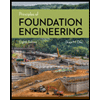Factor of safety calculations (b) (a) Calculate the factor of safety of the slope for the conditions given in Figure 6.15. Determine the factor of safety if the tension crack were completely filled with water due to run-off collecting on the crest of the slope. Determine the factor of safety if the slope were completely drained. (c) (d) Determine the factor of safety if the cohesion were to be reduced to zero due to excessive vibrations from nearby blasting operations, assuming that the slope was still completely drained. (e) Determine whether the 4.35-m deep tension crack is the critical depth (use Figure 6.6). Slope reinforcement using rock bolts (a) It is proposed that the drained slope with zero cohesion be reinforced by installing ten- sioned rock bolts anchored into sound rock beneath the sliding plane. If the rock bolts are installed at right angles to the sliding plane, that is, T = 55°, and the total load on the anchors per lineal meter of slope is 400 kN, calculate the factor of safety. (b) Calculate the factor of safety if the bolts are installed at a flatter angle so that the T is decreased from 55° to 20°. (c) If the working load for each bolt is 250 kN, suggest a bolt layout, that is, the number of bolts per vertical row, and the horizontal and
Factor of safety calculations (b) (a) Calculate the factor of safety of the slope for the conditions given in Figure 6.15. Determine the factor of safety if the tension crack were completely filled with water due to run-off collecting on the crest of the slope. Determine the factor of safety if the slope were completely drained. (c) (d) Determine the factor of safety if the cohesion were to be reduced to zero due to excessive vibrations from nearby blasting operations, assuming that the slope was still completely drained. (e) Determine whether the 4.35-m deep tension crack is the critical depth (use Figure 6.6). Slope reinforcement using rock bolts (a) It is proposed that the drained slope with zero cohesion be reinforced by installing ten- sioned rock bolts anchored into sound rock beneath the sliding plane. If the rock bolts are installed at right angles to the sliding plane, that is, T = 55°, and the total load on the anchors per lineal meter of slope is 400 kN, calculate the factor of safety. (b) Calculate the factor of safety if the bolts are installed at a flatter angle so that the T is decreased from 55° to 20°. (c) If the working load for each bolt is 250 kN, suggest a bolt layout, that is, the number of bolts per vertical row, and the horizontal and
Principles of Geotechnical Engineering (MindTap Course List)
9th Edition
ISBN:9781305970939
Author:Braja M. Das, Khaled Sobhan
Publisher:Braja M. Das, Khaled Sobhan
Chapter14: Lateral Earth Pressure: Curved Failure Surface
Section: Chapter Questions
Problem 14.3P
Related questions
Question

Transcribed Image Text:Statement
A 12-m high rock slope has been excavated at a
face angle of 60°. The rock in which this cut has
been made contains persistent bedding planes that
dip at an angle of 35° into the excavation. The
4.35-m deep tension crack is 4 m behind the crest,
and is filled with water to a height of 3 m above
the sliding surface (Figure 6.15). The strength
parameters of the sliding surface are as follows:
Cohesion, c = 25 kPa
Friction angle, d = 37°
The unit weight of the rock is 26 kN/m³, and the
unit weight of the water is 9.81 kN/m³.
Required
Assuming that a plane slope failure is the most
likely type of instability, analyze the following
stability conditions.
H=12m
TIRSTRIT
₁=60°
4m
➜
TRINIT TIKITRIT TINT
Z=4.35 m
p=35° Zw=3m
Figure 6.15 Plane failure geometry for Example
Problem 6.1.
Factor of safety calculations
(a) Calculate the factor of safety of the slope for
the conditions given in Figure 6.15.
(b) Determine the factor of safety if the tension
crack were completely filled with water due
to run-off collecting on the crest of the slope.
(c) Determine the factor of safety if the slope
were completely drained.
(d)
Determine the factor of safety if the cohesion
were to be reduced to zero due to excessive
vibrations from nearby blasting operations,
assuming that the slope was still completely
drained.
(e) Determine whether the 4.35-m deep tension
crack is the critical depth (use Figure 6.6).
Slope reinforcement using rock bolts
(a) It is proposed that the drained slope with
zero cohesion be reinforced by installing ten-
sioned rock bolts anchored into sound rock
beneath the sliding plane. If the rock bolts are
installed at right angles to the sliding plane,
that is, T = 55°, and the total load on the
anchors per lineal meter of slope is 400 kN,
calculate the factor of safety.
(b) Calculate the factor of safety if the bolts are
installed at a flatter angle so that the T is
decreased from 55° to 20°.
(c) If the working load for each bolt is 250 kN,
suggest a bolt layout, that is, the number of
bolts per vertical row, and the horizontal and
Expert Solution
This question has been solved!
Explore an expertly crafted, step-by-step solution for a thorough understanding of key concepts.
Step by step
Solved in 7 steps with 8 images

Knowledge Booster
Learn more about
Need a deep-dive on the concept behind this application? Look no further. Learn more about this topic, civil-engineering and related others by exploring similar questions and additional content below.Recommended textbooks for you

Principles of Geotechnical Engineering (MindTap C…
Civil Engineering
ISBN:
9781305970939
Author:
Braja M. Das, Khaled Sobhan
Publisher:
Cengage Learning

Principles of Foundation Engineering (MindTap Cou…
Civil Engineering
ISBN:
9781305081550
Author:
Braja M. Das
Publisher:
Cengage Learning

Principles of Geotechnical Engineering (MindTap C…
Civil Engineering
ISBN:
9781305970939
Author:
Braja M. Das, Khaled Sobhan
Publisher:
Cengage Learning

Principles of Foundation Engineering (MindTap Cou…
Civil Engineering
ISBN:
9781305081550
Author:
Braja M. Das
Publisher:
Cengage Learning